Operators
 United Kingdom
United Kingdom
| R36 | |
|---|---|
| General information | |
| Type | Passenger airship |
| National origin | United Kingdom |
| Manufacturer | Beardmore |
| Primary user | Air Ministry |
| Number built | 1 |
| History | |
| Manufactured | 1921 delivered |
| First flight | 1 April 1921 |
| Retired | June 1926 |
| Developed from | Type U Zeppelin L49 |
R.36 was a British airship designed during World War I, but not completed until after the war. When she first flew in 1921, it was not in her originally intended role as a patrol aircraft for the Royal Navy, but as an airliner, the first airship to carry a civil registration (G-FAAF). [1]
The design was produced by the new Airship Design Department, work commencing in November 1917. [1] She was a lengthened version of the German Type U Zeppelin L49 (LZ 96) captured intact at Bourbonne-les-Bains in October 1917. [2] The R.36, along with a second ship the R.37 were to be a stretched version of the L49, getting more lift by adding another 33 feet (10 m) gas bag. Two of her five engines were German Maybach engines, recovered from the downed LZ 113.
Construction began before the end of the war, but the design was altered to include accommodation for 50 passengers. [3] This was more than twice the number carried by the two German airships LZ 120 Bodensee and LZ 121 Nordstern built for passenger carrying.
Unlike the L49 Type U, the control car was not suspended below the hull but directly attached to it, and formed the forward section of the elongated passenger compartment. The engines were housed in five engine cars, one pair (containing the Maybach engines) on either side of the hull forward of the control car, a second pair either side of the passenger compartment and the fifth on the centreline in front of the tail surfaces. Unlike previous British airship designs, the fins and horizontal stabilisers were cantilevered structures, with no external bracing. [4]
R.36 was launched for her maiden flight on 1 April 1921 from the Beardmore works at Inchinnan near Glasgow. [1] Late the following day she flew on to RNAS Pulham in Norfolk.
On 5 April it left Pulham at 07:25am bound for London. After making its appearance over the city it proceeded to Salisbury Plain, where it climbed to 6,000 ft (1800 m) and began manoeuvring trials. Starting a fast turn of 130 degrees it encountered windshear, which overstressed the rudder, collapsing the top rudder and starboard elevator. [5] This made the ship adopt a nose down attitude and rapidly lose height, but it was brought under control at around 3,000 feet . Emergency repairs were made to the damaged control surfaces and the ship limped home on her one remaining rudder and elevator, using differential engine control to help with directional control, reaching Pulham at 9.15pm. [1]
After repairs and strengthening work she re-emerged in June for a successful series of test flights, including an endurance trial starting on 10 June which lasted nearly 30 hours, covering 734 miles (1,174 km) over land and sea. [1] She was also used by the Metropolitan Police for observing traffic congestion caused by the Ascot Races. Journalists and senior police representatives were entertained in great comfort on the day, and the journalists stories were dropped by parachute over Croydon airfield.
On 21 June, returning from another trial flight, she suffered damage during landing. The release of emergency ballast caused a sharp pitching up, straining the ship against the mooring line. The nearest unoccupied sheds were at Howden in Yorkshire since the Pulham sheds were holding German Zeppelins handed over as war reparations. The wind increased and it was decided that the LZ 109 (L 64) would have to be sacrificed to save the R.36. Within 4 hours L 64 had been cut into pieces and cleared to give enough room for R36. Even then she was damaged by a gust of wind during the manoeuvre into the shed.
Repairs were delayed while policy on airships was reviewed because of the R38 disaster and economic conditions. In 1925 she was refurbished for an experimental flight to Egypt as part of the Imperial Airship Scheme, but calculations cast doubt on her ability to make the trip as R.36 would require 13.65 tons of fuel for the trip, leaving only 2.35 tons for ballast, crew, passengers, cargo, and mail which was ridiculous. [6] In the light of her age and condition she was scrapped in 1926. The total flying time achieved by R.36 was less than 100 hours when she was broken up in June 1936. [5] The passenger accommodations of R.36 grotesquely exceeded the carrying capacity of the airship, something which was also true of the only other British passenger airships R.100 and R.101 which historian Robin Higham described as "a very real example of the predicament into which optimists landed themselves." [6]
Data from The Airship Heritage Trust [1]
General characteristics
Performance

LZ 129 Hindenburg was a German commercial passenger-carrying rigid airship, the lead ship of her class, the longest class of flying machine and the largest airship by envelope volume. She was designed and built by the Zeppelin Company on the shores of Lake Constance in Friedrichshafen, Germany, and was operated by the German Zeppelin Airline Company. She was named after Field Marshal Paul von Hindenburg, who was President of Germany from 1925 until his death in 1934.

LZ 127 Graf Zeppelin was a German passenger-carrying hydrogen-filled rigid airship that flew from 1928 to 1937. It offered the first commercial transatlantic passenger flight service. The ship was named after the German airship pioneer Ferdinand von Zeppelin, a count in the German nobility. It was conceived and operated by Hugo Eckener, the chairman of Luftschiffbau Zeppelin.
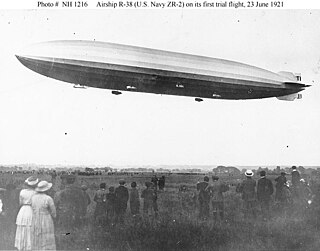
The R.38 class of rigid airships was designed for Britain's Royal Navy during the final months of the First World War, intended for long-range patrol duties over the North Sea. Four similar airships were originally ordered by the Admiralty, but orders for three of these were cancelled after the armistice with Germany and R.38, the lead ship of the class, was sold to the United States Navy in October 1919 before completion.

His Majesty's Airship R100 was a privately designed and built British rigid airship made as part of a two-ship competition to develop a commercial airship service for use on British Empire routes as part of the Imperial Airship Scheme. The other airship, the R101, was built by the British Air Ministry, but both airships were funded by the Government.

The R.33 class of British rigid airships were built for the Royal Naval Air Service during the First World War, but were not completed until after the end of hostilities, by which time the RNAS had become part of the Royal Air Force. The lead ship, R.33, served successfully for ten years and survived one of the most alarming and heroic incidents in airship history when she was torn from her mooring mast in a gale. She was called a "Pulham Pig" by the locals, as the blimps based there had been, and is immortalised in the village sign for Pulham St Mary. The only other airship in the class, R.34, became the first aircraft to make an east to west transatlantic flight in July 1919 and, with the return flight, made the first two-way crossing. It was decommissioned two years later, after being damaged during a storm. The crew nicknamed her "Tiny".

The R.80 was a British rigid airship, first flown on 19 July 1920, and was the first fully streamlined airship to be built in Britain. Originally a military project for the British Admiralty, it was completed for commercial passenger-carrying. R.80 proved too small for this role and after being used briefly to train the United States Navy personnel who were to crew the ZR-2 airship, R.80 was retired and eventually scrapped in 1925.
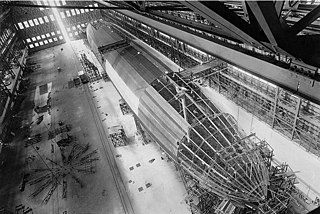
A rigid airship is a type of airship in which the envelope is supported by an internal framework rather than by being kept in shape by the pressure of the lifting gas within the envelope, as in blimps and semi-rigid airships. Rigid airships are often commonly called Zeppelins, though this technically refers only to airships built by the Luftschiffbau Zeppelin company.

The 23 class were rigid airships produced in the United Kingdom during the First World War. Development of the 23 class began in August 1915 when Vickers was asked to improve the 9r design by increasing its gas capacity by adding a bay and increasing the capacity of the bow and stern gas cells. The 23-class was designed by H.B. Pratt and Barnes Wallis of Vickers. Vickers built the first and last of the four ships. The other two were built by William Beardmore and Company and Armstrong-Whitworth. While the 23 class airships were never used in combat, the four ships provided many hours of valuable training and experimental data for British airship crews and designers. Although a total of 17 of these ships were contemplated at one time, only four were ever built. The 23 class was found to be significantly overweight, leading to its cancellation in favour of the more-refined R23X class.
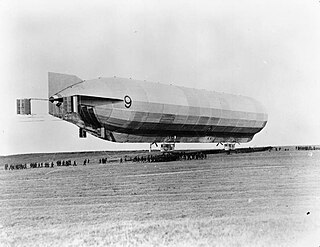
HMA No. 9r was a rigid airship designed and built by Vickers at Walney Island just off Barrow-in-Furness, Cumbria. It was ordered in 1913 but did not fly until 27 November 1916 when it became the first British rigid airship to do so. It was dismantled in June 1918 after being flown for around 165 hours, mainly for experimental purposes.
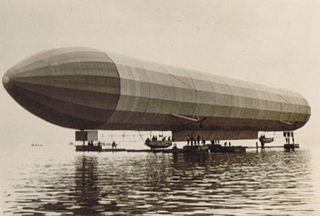
The LZ 2 was a German experimental airship constructed by Luftschiffbau Zeppelin and first flown in 1906. It was the true ancestor of later Zeppelin airship designs. The major mistakes made by Kübler in the design of the LZ 1 were not repeated: the designer, Ludwig Dürr, who was to head the design of all subsequent Zeppelins, used triangular-section girders instead of Kübler's flat girders, and elevators instead of a lead weight to control pitch. The life of the LZ 2 was brief, consisting of only two flights. Its near-sister ship, the LZ 3—which first flew on 9 October 1906—was purchased by the German Army and operated as the Z I until 1913. Before being purchased by the Army, LZ 3 made many flights and carried a number of prestigious passengers, including the German Crown Prince.

The ZeppelinLZ 1 was the first successful experimental rigid airship. It was first flown from a floating hangar on Lake Constance, near Friedrichshafen in southern Germany, on 2 July 1900. "LZ" stood for Luftschiff Zeppelin, or "Airship Zeppelin".

LZ 10 Schwaben was a German rigid airship built by Luftschiffbau Zeppelin in 1911 and operated by DELAG for passenger service. It is regarded as the first commercially successful passenger-carrying aircraft.

The ZeppelinLZ 4 was a German experimental airship constructed under the direction of Ferdinand von Zeppelin. First flown on 20 June 1908, it made a series of successful flights including a 12-hour flight over Switzerland. It was destroyed when it caught fire after landing to carry out engine repairs during a projected 24-hour endurance trial. This disaster proved fortunate for Zeppelin: donations by the German public raised 6.5 million marks, so guaranteeing the future of his development of airships.

LZ 120 Bodensee was a passenger-carrying airship built by Zeppelin Luftschiffbau in 1919 to operate a passenger service between Berlin and Friedrichshafen. It was later handed over to the Italian Navy as war reparations in place of airships that had been sabotaged by their crews and renamed Esperia. A sister-ship, LZ 121 Nordstern, was built in 1920: it was handed over to France and renamed Méditerranée.
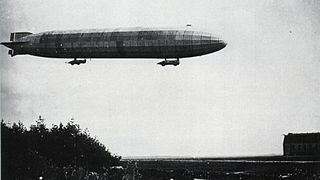
The Zeppelin P Class was the first Zeppelin airship type to be produced in quantity after the outbreak of the First World War. Twenty-two of the type were built as well as twelve of a lengthened version, the Q Class. They were used for many of the airship bombing raids on the United Kingdom in 1915-16, for naval patrol work over the North Sea and Baltic and were also deployed on the eastern and south-eastern fronts.

The Zeppelin R Class was a type of rigid airship developed by Zeppelin Luftschiffbau in 1916 for use by the Imperial German Navy and the German Army for bombing and naval patrol work. Introduced in July 1916 at a time when British air defences were becoming increasingly capable, several were lost in the first months of operation, leading the Germans to reconsider their technical requirements and eventually to develop airships capable of bombing from a greater height. Most surviving examples were modified to meet these requirements, by reducing weight at the expense of performance. A total of 17 were built.
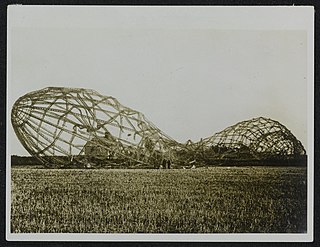
The Imperial German Army Zeppelin LZ 76 (L-m33) was a R-class World War I zeppelin.

Zeppelin LZ 89 was an R-class zeppelin of the Imperial German Navy. After a short career during the World War I it ran out of fuel during a mission and was deliberately crashed.